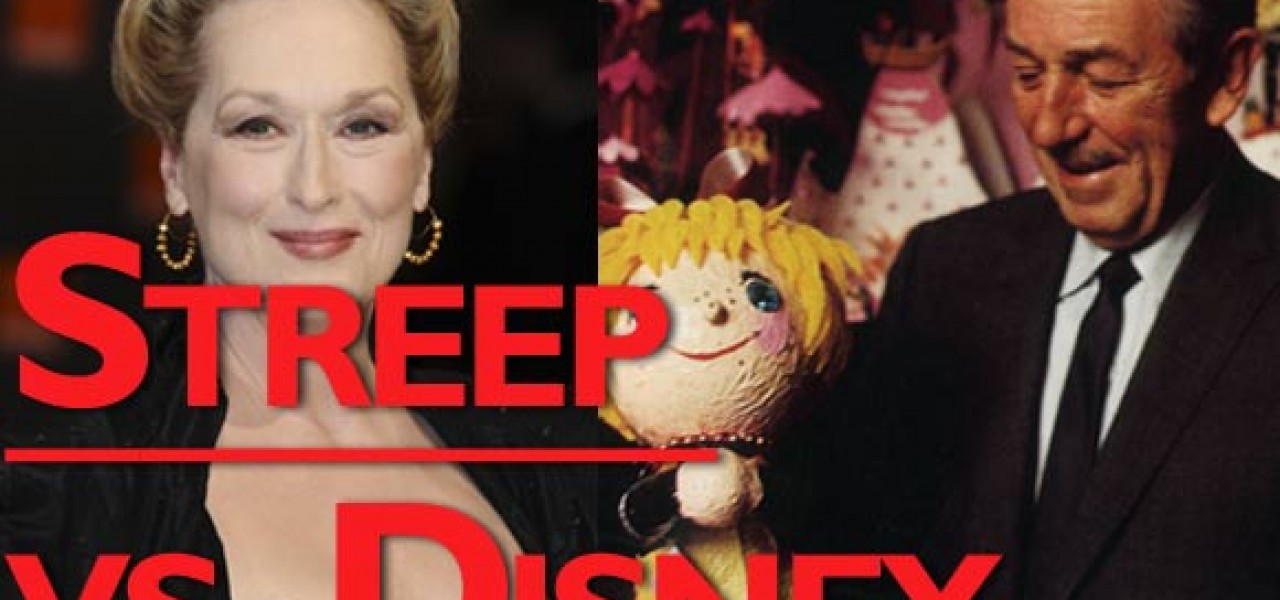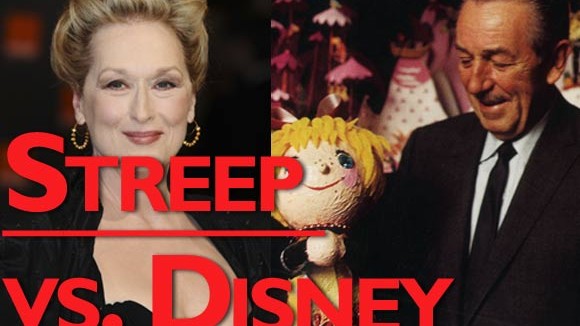

Fact-Checking Meryl Streep’s Disney-Bashing Speech
While there are surely many things that the actress Meryl Streep can do well, critical thinking and historical research will not appear at the top of that list anytime soon. At the National Board of Review dinner a few nights ago, Streep made headlines when she bashed Walt Disney while presenting the best actress award to Emma Thompson, for her role as P.L. Travers in the Walt Disney biopic Saving Mr. Banks.
As part of a nearly ten-minute speech, Streep lobbed countless nasty, well-worn accusations at Disney, characterizing him as a racist, an anti-Semite, and a ‘gender-bigot.’ Her demonization of Disney was wildly applauded all over, but for all her frankness, she displayed massive ignorance about both Walt Disney’s life and American history. Every statement she made about Disney was either grossly distorted or outright false. Here’s a fact-check of Streep’s Walt-bashing:
MERYL STREEP: “Some of [Walt Disney’s] associates reported that Walt Disney didn’t really like women. Ward Kimball, who was one of his chief animators, one of the original “Nine Old Men,” creator of the Cheshire Cat, the Mad Hatter, Jiminy Cricket, said of Disney, ‘He didn’t trust women, or cats.'”
FACT: As the family-approved biographer of Ward Kimball, I’m tickled to see Ward quoted in a public venue. But it also pains me to see Ward’s words taken out of context to serve someone else’s personal agenda. I’ve read thousands of pages of Ward’s writings, including his personal diaries, and I can say unequivocally that Ward never felt Walt Disney ‘didn’t really like women.’ In the quote, Ward claims that Walt was suspicious of women, but I don’t know the context of that statement. And guess what, Meryl doesn’t know the context either. That’s the entirety of the quote published in Neal Gabler’s biography of Walt Disney, stripped of all its original nuance and meaning. We can only assume that there was something that Kimball said that preceded and followed his soundbite-worthy statement. The fact that Kimball listed both women and cats in the same sentence suggests that he was being playful and facetious, a reflection of his personality. He would have likely cringed to see someone misappropriating his comments to attack a man whom he deeply respected and admired.
MERYL STREEP: “Disney…was perhaps…or had some racist proclivities.”
FACT: Streep provides no specific accusations here. So let me just say this: no respected Disney historian has ever uncovered evidence that Walt Disney was racist. And goodness knows, we’ve digged in every corner. There is evidence that Walt uttered politically incorrect remarks (in a less sensitive era and long before the concept of ‘political correctness’ ever existed). However, after thousands of interviews with his employees and an immense paper trail, zero evidence has surfaced that he engaged in discriminatory acts against any individual based on race, ethnicity, color, religion, or sex. It’s safe to say at this point that as a visionary futurist, Disney did not believe in running his company or behaving in a racist manner.
MERYL STREEP: “And he was certainly, on the evidence of his company’s policies, a gender bigot.”
FACT: Streep’s accusation stems from a 1938 letter written to a prospective employee. Streep read from it during her speech:
“Dear Miss Ford, your letter of recent date has been received in the inking and painting department for reply. Women do not do any of the creative work in connection with preparing the cartoons for the screen, as that task is performed entirely by young men. For this reason, girls are not considered for the training school. The only work open to women consists of tracing the characters on clear celluloid sheets with India ink, and then, filling in the tracing on the reverse side with paint according to directions.”
Firstly, this letter is not some kind of smoking gun. It was a basic form letter that was copied almost verbatim from the studio’s 1938 employee policies handbook. John Canemaker quoted the exact same policy in his 1996 book Before the Animation Begins: The Art and lives of Disney Inspiration Sketch Artists. The information in that book remained largely ignored for seventeen years, and it wasn’t until this random letter appeared online a few years ago that people suddenly became aware of this historical tidbit.
Here’s the reality: this policy was not unique to the Disney studio. It was a universal policy exercised by every single animation studio during the 1930s. The hierarchy was always the same: the vast majority of women worked in ink-and-paint, men worked exclusively in story, art direction and animation. Was it right? No. Was it American society in the 1930s? You betcha’. There were more industries then than today that were organized along gender lines. Women were also underrepresented throughout the workforce; the U.S. government launched propaganda campaigns in the early-1940s to encourage woman to work, so it could fill manpower shortages in the factories.
If Walt’s behavior makes him a gender-bigot, then it would only be fair to label every other animation studio head, not to mention nearly all industrialists, CEOs, political figures and businessmen from that era, as such, too. But from Streep’s perspective, it’s perfectly acceptable to isolate Walt Disney from the timeline of American history and hold him to the standards of 2014, while the rest of 1930s America gets a free pass.
But there’s another dimension to this issue, as well, that makes Streep’s comments outright false. Despite the official policy of the Disney studio being that women would only work in ink-and-paint, Walt ignored his own company’s policy time and time again. He always promoted women into different positions based on their skillsets. In the Thirties and Forties, dozens of women worked in traditionally male positions, occupying spots in animation (Retta Scott, Mildred Rossi), art direction (Mary Blair), visual development (Sylvia Moberly-Holland), assistant direction (Bee Selck), story (Bianca Majolie, Dorothy Ann Blank, Sterling Sturtevant), character model (Lorna Soderstrom, Fini Rudiger), background painting (Thelma Witmer, Ethel Kulsar), promotional art and advertising (Gyo Fujikawa), music editing (Louisa Field), and assistant animation and inbetweening (Freddie Blackburn, Sylvia Niday, Sally Holmes, Elinor Fallberg, Mary Schuster, and Grace Stanzell in the 1940s, to name but a few, and joined in the 1950s by others like Lois Blumquist, Elizabeth Case, Retta Davidson, Eva Schneider, Dolores Apodaca, Bea Tomargo, Jane Shattuck and Sylvia Frye). As a percentage of his employees, more women worked in non-ink-&-paint artistic positions at Disney between the 1930s and 1950s than any other Golden Age animation studio.
RELATED: Walt Disney Was No “Gender Bigot”
MERYL STREEP: “He formed and supported an anti-Semitic industry lobbying group.”
FACT: This is the most grotesquely misinformed statement presented by Streep during her vitriolic speech. Streep is referring to Walt’s involvement in the formation of the Motion Picture Alliance for Preservation of American Ideals (MPA). This was not a fringe organization nor was its purpose anti-Semitism. It was a mainstream, if miguided and reactionary, organization enacted by the movie industry’s conservative elite, and its membership included a who’s who of Hollywood, among them directors Cecil B. DeMille, John Ford, Norman Taurog, King Vidor, Victor Fleming, Leo McCarey and Sam Wood; actors John Wayne, Gary Cooper, Ginger Rogers, Clark Gable, Barbara Stanwyck, Robert Montgomery, George Murphy (who later became a U.S. Senator) and Ronald Reagan (who later became president of the United States); MGM art director Cedric Gibbons; and gossip columnist Hedda Hopper.
When the MPA was formed in 1944, of which Disney became its first vice-president, its agenda was spelled out clearly in the group’s mission statement:
We believe in, and like, the American way of life: the liberty and freedom which generations before us have fought to create and preserve; the freedom to speak, to think, to live, to worship, to work, and to govern ourselves as individuals, as free men; the right to succeed or fail as free men, according to the measure of our ability and our strength.
Believing in these things, we find ourselves in sharp revolt against a rising tide of communism, fascism, and kindred beliefs, that seek by subversive means to undermine and change this way of life; groups that have forfeited their right to exist in this country of ours, because they seek to achieve their change by means other than the vested procedure of the ballot and to deny the right of the majority opinion of the people to rule.
In our special field of motion pictures, we resent the growing impression that this industry is made of, and dominated by, Communists, radicals, and crackpots. We believe that we represent the vast majority of the people who serve this great medium of expression. But unfortunately it has been an unorganized majority. This has been almost inevitable. The very love of freedom, of the rights of the individual, make this great majority reluctant to organize. But now we must, or we shall meanly lose “the last, best hope on earth.”
The group’s formation has to be viewed in the context of the much bigger ideological and cultural turfwar that was taking place in Hollywood at the time. The era and its politics are extensively documented in the recent book When Hollywood Was Right: How Movie Stars, Studio Moguls, and Big Business Remade American Politics. As part of that era’s politics, name-calling was fervent (sound familiar?). Conservatives referred to liberals as Pinkos, New Dealers, and Commies. Liberals, in turn, branded conservatives, like Walt, as Fascists and anti-Semites. Labelling the MPA an anti-Semitic organization was a rhetorical tactic used by the left to attack it, and while there were surely anti-Semites in the group, it was not an inherently anti-Semitic organization nor was that Walt’s reason for being involved in the group.
Walt’s involvement with the MPA peaked in 1947 when the group’s members testified in Washington D.C. in front of the House Un-American Activities Committee. Disney was among those who spoke as a “friendly” witness and he called out the leader of the Disney studio strike, David Hilberman. Disney presumably felt vindicated after exposing who he believed were subversive elements within the Hollywood industry, because his involvement in the MPA—minimal as it had been—waned after his testimony. Disney’s actions speak powerfully to the notion that his involvement in the group was to settle personal scores against those whom he felt had wronged him, and never an ideological stance against Jews.
(Meryl Streep photo: Shutterstock/FeatureFlash)

.png)